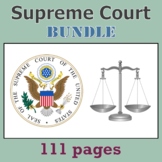Supreme Court - Learn about Landmark Cases - Internet Activity
- PDF
- Internet Activities
- Easel Activity
What educators are saying
Also included in
- This BUNDLE has 111 printable pages for students to learn about the Supreme Court, including nominee Ketanji Brown Jackson and recent jurists Amy Coney Barrett and Brett Kavanaugh:Internet Activity,All nine current Justices,Former Justices,Landmark Cases,Hot Issues and Topics,Five packets bundled toPrice $7.50Original Price $13.00Save $5.50
Description
27 printable or digital pages for students to research landmark cases that appeared before the supreme court. Students use a laptop, tablet or smart phone to search the INTERNET to identify the petitioner and respondent, the location, the lawyers and Chief Justice, the origination, the issue, the result, and the importance of the case to today:
- Marbury v. Madison (1803),
- McCulloch v. Maryland (1819).
- Gibbons v. Ogden (1824),
- Dred Scott v. Sandford (1857),
- Schenck v. United States (1919),
- Brown v. Board of Education (1954),
- Cooper v. Aaron (1958)
- Mapp v. Ohio (1961)
- Engel v. Vitale (1962),
- Gideon v. Wainwright (1963),
- New York Times v. Sullivan (1964),
- Miranda v. Arizona (1966),
- Terry v. Ohio (1968),
- Tinker v. Des Moines (1969),
- Roe v. Wade (1973),
- U.S. v. Nixon (1974),
- Goss v. Lopez (1975),
- Regents of the University of California v. Bakke (1978),
- New Jersey v. T.L.O. (1985),
- Bethel School District #43 v. Fraser (1987),
- Hazelwood v. Kuhlmeier (1988),
- Texas v. Johnson (1989),
- Santa Fe Independent School District v. Doe (2000),
- Zelma v. Simmons-Harris (2002),
- Board of Education of Independent School District #92 of Pottawatomie County v. Earls (2002),
- Grutter v. Bollinger (2003),
- Roper v. Simmons (2005).
PRINT: I created a PDF version that you can download on your computer and print for students to use in class or at home. Click on "Add one to cart" and download your copy.
DIGITAL ACTIVITY: I created a digital version with text boxes so students can type in the answers using a computer or tablet (for Distance Learning). Click on "Create Digital Activity" and link the activities to your Google Classroom. Online Resource. Yes, I already added the interactive layer to each page. Enjoy!
Take a look at the Preview to see sample pages. And if you want more on the SUPREME COURT:
Supreme Court - Ketanji Brown Jackson - 10 pages
Supreme Court Issues and Topics - 32 pages
Learn about the Justices of the Supreme Court - 27 pages
Supreme Court - Learn about Landmark Cases - 17 pages
Amy Coney Barrett - Write a Descriptive Paragraph - 15 pages







